- Home
- Lower back exercises
- Maignes Syndrome Exercises
Maignes Syndrome Exercises
These Maigne's syndrome exercises have been specifically designed for the
- Quadratus Lumborum,
- the Multifidi and the Intertransversarii muscles and
- the upper lumbar facet joints.
There is considerable evidence that it is the small stabilizer muscles, the inter transversarii and the multifidi, linking across one, two and three vertebrae, that are weak in patients suffering from chronic low back pain.
There are three basic types of Multifidi muscles: All originate from the spinous processes, the big bumps felt in the back, passing to either
- the
Mammilary process, (spinous-mammilary)
- the Posterior Superior Iliac Spine PSIS or (spinous-PSIS)
- the sacrum.(spinous-sacrum)
Weak back? Think MAIGNES SYNDROME EXERCISES, amongst other things.
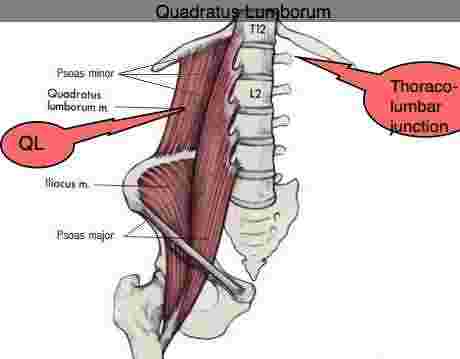
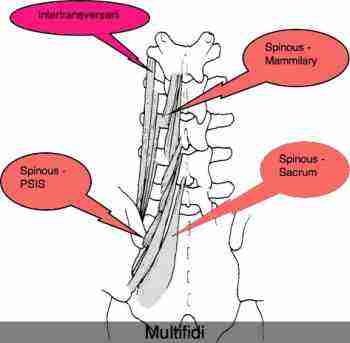
What is MAIGNE'S SYNDROME?
Maigne's syndrome is a collection of obscure symptoms emanating from irritation of the Superior Cluneal nerves originating in the upper lumbar region. These nerves are sensory to the central upper part of the buttock.
Because the pain is located in and around the sacroiliac joint anatomy the lower lumbar facets joints, the Gluteal and Piriformis and lower QL muscles, Maignes syndrome is difficult to diagnose, often providing unusual and inconclusive pain patterns. Maigne's syndrome casefile brings out how this makes for a diagnostic nightmare.
Sciatic and Femoral nerve stretch tests will most likely be negative. There may be some vague sensory changes but no motor abnormalities.
These Maigne's syndrome exercises are designed to help prevent this. They may do little or nothing to alleviate the pain once you have it. The SLUMP test too will usually be negative. Use the site search function to find out more about Maigne's syndrome.
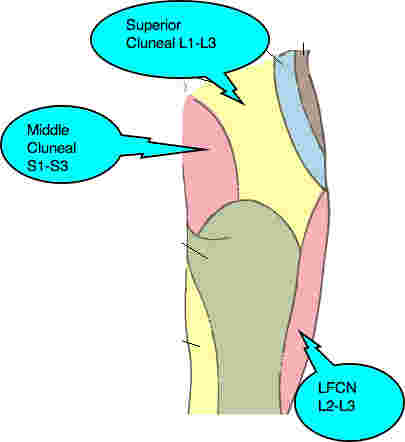
- Sacroiliac joint anatomy ...
- Maignes syndrome case file ...
- Flip test for sciatica
- Read more about MAIGNES SYNDROME …
Groin pain
Other nerves such as the ilio-hypogastric nerve and the Lateral Femoral Cutaneous nerve (LFCN) emerge from this same area of the upper lumbar spine, with the result that Maigne's syndrome may well be accompanied by groin and upper thigh pain.
Read more about upper thigh pain.
Chiropractic treatment
Treatment will consist, in the main, of Chiropractic adjusments of the offending lumbar segments in the upper lumbar spine, and soft tissue therapy to the QLs and deep stabilisers.
The presence or absence of a short leg will be considered. Read more about LEG LENGTH INEQUALITY ...
Rehabilitation
Two specific Maignes syndrome exercises that I use with some success are:
- Pelvic tilt
- Hip hike
Maignes Syndrome Exercises
PELVIC TILT with a difference
Maignes syndrome exercises have been specifically designed for the QL muscle and the lower back facets joints.
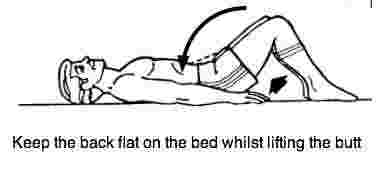
In the standard Pelvic Tilt, the patient keeps the back flat on the bed, drawing in and tightening the abdominal muscles. It's a perfectly good exercise. As a Maignes syndrome exercise, I expand it in four ways, best done in stages. When the patient can do each stage confidently, and smoothly, AND WITHOUT SIGNIFICANT PAIN, only then move onto the next stage.
Stage I: The Basic Pelvic Tilt
First thing in the morning, before getting out of bed, flex the hips and knees, place the hands at your sides, palm down, and draw in the "stomach", keeping the back flat on the bed, and then slowly and deliberately lift the buttocks, whilst still pulling in the tum. To the point of pain, if there is one. Don't overshoot the pain boundary.
Why on the bed? In my experience, if not done first thing in the morning, back exercises never get done. The demands of the day override. And if you have this condition, then you should be doing Maignes Sydrome exercise, EVERY DAY, regardless of whether you have pain or not. And doing them on the soft surface of the bed (not a waterbed) is just fine.
Stage II: Add in the Deep Pelvic muscles
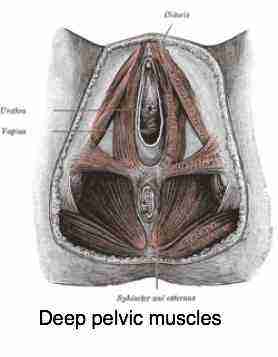
The deep pelvic muscles are oft-neglected and make up a very
important part of the Lumbar corset muscles. In any case, in the young
it improves sexual performance (men and women), and in the elderly helps
to prevent the leaking bladder syndrome. There are many benefits from
the MAIGNES SYNDROME EXERCISES!
Read more about the Deep Pelvic muscles… KEGEL EXERCISES
Read more about toning abdominal muscles…
BEFORE starting the basic pelvic tilt, tighten the deep pelvic muscles,
perhaps best done by imagining that you need to abruptly stop urinating.
Now proceed with the normal pelvic tilt.
Then relax both the Deep pelvic muscles, and the tummy muscles, and drop the buttocks back onto the bed.
Repeat 10 times. Or more, or less, depending on the dictates of the day, but at least do a few MAIGNE'S SYNDROME EXERCISES every morning.
Stage III: Add in back extension.
If you have pain in the back, do Stage III very deliberately and slowly. This part of the MAIGNE'S SYNDROME EXERCISES may give you sharp stabs of back pain.
Do stages I and II as above but, on relaxing the tum and bladder muscles and lowering the buttocks, continue the movement and slowly arch the back. Now you are using those MULTIFIDI muscles from the top of this page.
Then lower the back onto the bed again, and now proceed with first the bladder sphincter muscle contraction, followed by the tum muscles, keeping the back flat on the bed, and raising the buttocks again (as in Stage II).
Develop a slow rhythmical rocking exercise, first flexing the spine, and then extending it, focussing at each stage on first the bladder sphincter muscles, then the tum muscles, then relaxing both and contracting the small intrinsic back muscles as you arch your back. SLOWLY AND RHYTHMICALLY.
Stage IV: The deep Neck flexors and extensors.
Practise this phase of the first, completely apart from the pelvic tilt. Then, when you can do it rhythmically and condidently, we'll add it into the Maignes Syndrome Exercise.
Lying in the pelvic tilt position, gently contract the neck muscles, lifting your head a miniscule from the pillow, BUT MAKING SURE YOU CAN STILL FEEL THE PILLOW AGAINST YOUR HAIR.
Don't raise your head completely, it may cause neck pain. At all times keep your head in contact with the pillow.
Lower your head, and now press your head quite firmly down against the pillow.
Repeat, in a slow rhythm, first tightening the neck flexor muscles and SLIGHTLY raising your head, and then the neck extensor muscles.
When you can do this confidently and smoothly, proceed to Stage V.
Note: Some people just have good coordination, and can learn these steps very quickly. If you're not one of them, don't worry. Rome wasn't built in a day, and what's important is that you get to Stage VI within a few weeks. Doing this exercise correctly is more important that rushing through these steps and missing some vital feature. I take several weeks with most patients to teach them to do it correctly. Some, true, can learn it in one consultation.
Stage V: Add the neck muscle contraction to the pelvic tilt.
Start by contracting the deep pelvic muscles (can you feel them by now, it's quite different to contracting the tummy muscles?), then the tummy muscles, raise the buttocks, AND NOW SLOWLY CONTRACT THE ANTERIOR NECK MUSCLES, keeping your head in contact with the pillow.
Relax everything, and drop the buttocks.
Continue the motion by now arching the back, pressing the buttocks down into the bed, AND PRESSING YOUR HEAD DOWN AGAINST THE PILLOW.
Relax everything, and lower the back onto your bed again. Continue with the cycle of this MAIGNES SYNDROME EXERCISE. Comprehendo? Got it?
Stage VI: Hands under the back.
Now for the bit that makes this specifically a MAIGNES SYNDROME EXERCISE.
Lying flat on the back, on your bed, with knees and hips flexed, instead of placing your hands at your side, PLACE THEM PALM DOWN, fingers right and left slightly over lapping, under your back. Start as high as you can reach - in the thoraco-lumbar junction, the area where Maigne's syndrome occurs.
Do your Stage V exercise now, using your hands as the pivot where the spine will arch. It makes the exercise far more specific, and you can exercise each joint systematically. Do two or three pelvic rocks (with the bladder sphincter and neck muscles included of course. This is a mental exercise too! You won't get Alzheimers!).
Now move the hands down one level towards the low back. Another two or three rocks. Systemically move downwards, one vertebra at a time, until you reach the sacrum, and then move slowly, step by step, back up towards the midback. If you are in pain, then do it very slowly, until you reach the pain boundary, and then reverse the movement again.
THIS EXERCISE SHOULD NOT CAUSE SIGNIFICANT PAIN. Some discomfort, yes. A good exercise reaches the pain, but doesn't overstep it.
Eventually you may want to graduate to fists instead of flat hands, depending on the hardness of your bed.
Phew, that was exhausting, just writing it up, only doing a few bladder contractions to FEEL the difference. Can you FEEL them? Not the same as the tum muscles. Like I said, it takes most people several sessions over a few weeks to learn to do this correctly.
Thought: There's a substantial body of Chiropractors, amongst whom I number, who think that a difficult exercise like this MAIGNE SYNDROME EXERCISE should only be taught and learned under the guidance of a professional. It's tricky and must be done correctly, and is not appropriate for every back. DISCUSS THIS PAGE WITH YOUR CHIROPRACTOR. Get his/ her confirmation, and ask if you are doing it correctly. Good luck.
You won't find this exercise in any text. I myself suffered from Maignes periodically, and I developed this exercise for my own back. I now do it EVERY DAY and have little difficulty with MAIGNES SYNDROME any more. I do ten reps in 25 seconds.
Hip hike
We started this page with a short anatomy lesson. The hip hike is the exercise for the QL (Quadratus Lumborum) muscles.
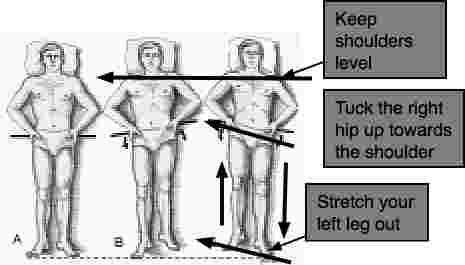
To do this Maignes syndrome exercise, lying flat on your back on your bed, first thing in the morning, stretch out the left leg, pulling the right hip towards your right shoulder, keeping both legs flat on the bed. Repeat with the other leg. In the acute phase this exercise is sometimes done best with the knees and hips bent. Try it both ways.
The beauty of the Hip Hike is that you alternately activate and stretch the Quadratus Lumborum and Multifidi muscles, mobilise the facet joints and exercise the disc joint keeping it well hydrated.
Every morning! First thing. I can do ten in 10 seconds. So easy. Actually I do this MAIGNES SYNDROME EXERCISE first.
Doing exercises lying on your bed first thing in the morning has two great advantages; it reminds your neurological system that your body has awoken and is about to require activity from the muscles as you bend to wash your face, for example.
The advantage is that they actually get done; once the business of the day gets going, many folk find that attention to their lower back gets forgotten if they are not currently having trouble; prevention is forgotten, not matter how bad the last epidsode of lower back and leg pain was.
But there's a disadvantage too; most of activity obviously is not done in bed but when we are sitting, standing and walking. An additional more general exercise programme is also needed. Walking, swimming and skipping are three good choices. Another are workouts like this at Abdominal Exercises for Women.
- Home
- Lower back exercises
- Maignes Syndrome Exercises
Did you find this page useful? Then perhaps forward it to a suffering friend. Better still, Tweet or Face Book it.
